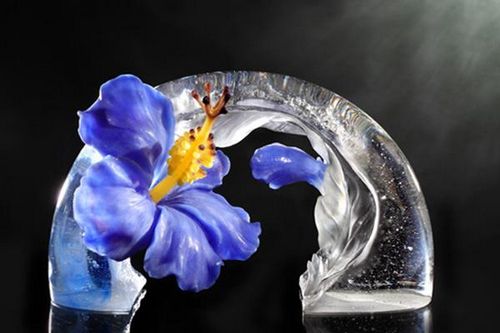
A work of liuli. (Source: People's Daily Online)
To celebrate the 50th birthday of the National Art Museum of China, the institution has unveiled its new exhibition "Uncovering Liuli in the Mortal World". Visitors are fascinated not only by the work on display, but also by the artists' personal lives.
"Liuli" is a type of crystal glass. Artists Yang Huishan and Chang Yi have become synonymous with the name as they explore and break boundaries using the medium. The artists consider liuli to be the best way of expressing the human experience.
"Behind the shine and elegance of liuli is the vigilance and intranquility it brings to people, as any slightest slip and drop will destroy whatever beauty it boasts. This is why liuli has impressed and inspired our Liuligongfang workshop," Chang Yi said.
One of Liuligongfang's most prominent works is 'A Chinese Liuli Flower'. It looks so real that it seems as if you can feel its fragile petals and almost smell it. The flower can be seen to symbolise how the couple's liuli career started from scratch 26 years ago and has continued to grow and blossom ever since.
The artistic couple became household names in Taiwan in the 1970s in the film industry. As an actress, Yang Huishan, also known as Loretta Yang, was once named Best Actress at the Asia Pacific Film Festival and also received a Taiwan Golden Horse film award. Chang Yi formally won accolades for his directing work.
However, at the height of their careers in the late 1980s, the pair left the film industry, deciding instead to blaze a new trail in the art of liuli, a field they knew nothing about.
Their workshop, Liuligongfang, was established in 1987. At the time, the pâte-de-verre wax casting technique was all but extinct, except in one workshop in France. The desire to use this method almost drove the couple broke.
"It was a crazy gamble," Chang said. "Especially when we saw all the money we were throwing into the technique. A lot of our trials ended up as ash! We often questioned our choice. But our family helped us out. When Huishan needed money, her sister mortgaged her house for us. We had no other choice but to plough on."
As Chang Yi says, his wife is determined, and after a long and arduous three-and-a-half months the couple finally succeeded. As the two were proudly exhibiting their work created by using the French technique, they were told by Japanese scholars that several years earlier a pair of liuli cups had been found in China's Hebei province. At least 2,100 years old, the cups are thought to be China's earliest example of high lead liuli glass created using the very same pâte-de-verre technique.
The news came as a shock to the artists. "I felt that it was a shame because we, being Chinese, were oblivious to our own history. On the other hand, we were also shocked because we had invested so much money in high-tech equipment and research, but we still only know a fraction of what our ancestors had already mastered over 2,000 years ago," Chang said.
Today, some 26 years on from their humble beginnings, Yang Huishan is widely recognized as the "pioneer of Chinese liuli art" and the New York Times has dubbed Chang Yi "The Father of the Asia Studio Glass Movement". Their workshop now operates 70 galleries around the world, with works presented as national gifts to at least 32 world leaders and awarded at both the Oscars and the Grammy Awards.
In 2006 the artists founded the Liuli China Museum in Shanghai, collecting and conserving ancient and contemporary liuli, from East to West, past and present.
"Looking back 20 years to the first liuli art exhibition at the Palace Museum in 1992," said Chang, "we borrowed the ancient liuli cups from the Hebei Museum. On display in the center of the hall, the caption read: 'This is where we begin'."
The exhibition will run until the middle of May. One of the pieces on display will be auctioned and the money will be donated to the victims of the recent Lushan earthquake.
The artists are perfectionists, as the dozens of pieces deemed substandard in their studio attest to. Yang Huishan won't stop until the perfect piece is born. And considering each piece takes 6 to 8 months of meticulous work to complete, this can be a frustrating process. Both have had their fair share of health scares, possibly attributed to their hard work. Yang Huishan has lost the hearing in her left ear, and Chang Yi has suffered heart disease for years.
The pair's story of courage and hard work against the odds is an inspiring one and one which we hope will continue for many years to come.

Copyright ©1999-2011 Chinanews.com. All rights reserved.
Reproduction in whole or in part without permission is prohibited.